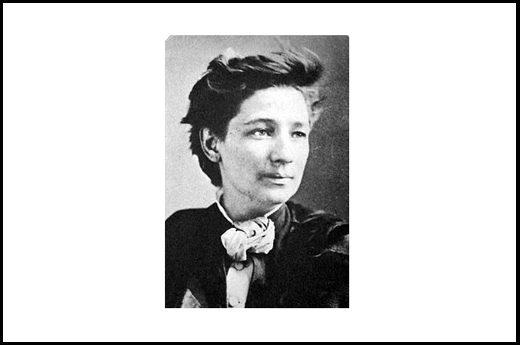by guest blogger Maya Rodale, author of smart and sassy romance novels
With the election looming and “the women’s vote” more courted then ever, there’s no better time to share the story of Victoria Woodhull, one of history’s most daring and audacious women.
The story of Victoria Woodhull is the story of the first woman to run for president. And the story of the first female stockbroker, the first female publisher, and the most controversial and popular advocate of free love. Hers is the story of a woman who injected much-needed spark into the suffrage movement when it was losing its fire. It’s the story of a woman in late-1800s America the scandalizing the nation with a life that was in her own words “ahead of its time.”
She was born in a small town in Ohio in 1838 to the large, eccentric family on the outskirts of town. At just 14, she married Dr. Canning Woodhull, who turned out to have a very limited medical practice and a very extensive drinking problem. The girl who’d had only three years of schooling quickly got a crash course in life.
With her sister Tennessee, Victoria started into business as a clairvoyant. Her father had given her one good piece of advice: “Be a good listener.” And listen she did, as she and Tennie and the family traveled around America just after the Civil War listening to the stories of husbands, wives, prostitutes, and anyone else who paid to have their fortune told. This work probably gave Victoria a unique understanding of and insight into her future audience; while most prominent suffragists preached to the converted women of the upper class, she would reach out to unite all women, all men, rich and poor, and the huge spiritualist faction. Listening to the stories of unhappy women trapped by circumstance, as well as living her own similar tale, convinced her of the need for free love, the necessity of education for girls, and the need to fight for rights for women.
In 1869, after a new marriage and a move to New York City, and with a friendship with Cornelius Vanderbilt formed, she and her sister opened a brokerage firm, Woodhull, Claflin & Company. The press called the two the “bewitching brokers.” But with the backing of Vanderbilt and their own sharp street smarts, the sisters made almost $600,000 (millions in today’s money) in their first few weeks in business.
In 1870 Victoria launched Woodhull and Claflin’s Weekly. One journalist described it as “a 16-page paper [that] dealt in finance and fashion, stock jobbing and strong-minded women, sporting[s]…politics and president-making, supporting a woman even for the executive mansions…[published by] two sisters who seem capable of accomplishing what they undertake.” The weekly also published the first English translation of The Communist Manifesto.
In 1871 Victoria took the woman’s movement to Congress. While the suffragists had been lobbying for a 16th Amendment giving women the right to vote, Victoria declared that the constitution already gave them the right in the 14th Amendment, which stated that “All persons born or naturalized in the United States, and subject to the jurisdiction thereof, are citizens of the United States…No state shall make or enforce any law which shall abridge the privileges or immunities of citizens.” She took this message straight to Congress, becoming the first woman ever to address the House of Representatives. Of this speech, even an anti-suffrage paper, The Tribune, offered praise, saying, “All the past efforts of Miss Anthony and Mrs. Stanton sink to insignificance beside the ingenious lobbying of the new leader and her daring declaration.”
She was also giving lectures that when described today sound like rock concerts. Thousands of people would turn up, even in the worst weather. Society women packed in next to prostitutes, rich and poor men attended, and people stood in the aisles when all the seats were taken. Her most popular speech topic? Free love. This isn’t the smutty advertisement it sounds like. One biographer summed it up: “the essence of her system being that marriage is of the heart and not of the law, that when love ends marriage should end with it, being dissolved by nature, and that no civil statute should outwardly bind two hearts which have been inwardly sundered.” Victoria had seen the hard and dark side of marriage; she had listened to the stories of women who suffered in its confines. She endorsed monogamous relationships as long as the love was there. She practiced what she preached and caused a scandal by saying, “I am a free lover.”
While this idea was controversial, it was a speech she gave in 1872 that was so scandalous the newspapers wouldn’t even reprint what she said. In short, she attacked the capitalist system. She referred to the “C-word”—communism. She attacked the rich, naming even Vanderbilt. Friends started to distance themselves. A depression hit, and her brokerage firm closed. Victoria, who had raised herself from nothing to riches, was broke. Even the Weekly temporarily suspended publication.
On Election Day of 1872, after having declared her candidacy for presidency, Victoria and her sister Tennie were in jail on obscenity and libel charges while her name appeared on ballots across the country. The charges were ridiculous, the trials even more so. Her suffragist friends distanced themselves. Susan B. Anthony in particular lashed out to condemn her. The sisters, once freed, set sail for England.
In England they turned themselves into respectable ladies as best they could. Victoria denied her past, even going as far to change her name to Woodhall. But then, Victoria the advocate of free love found true love. His name was Joseph Biddulph Martin, an established and respected banker. He supported her unconventional beliefs and was seemingly unfazed by her scandalous behavior—which was still apparent when she raced her motorcar around her estate. She died at the age of 90, in 1927, having outlived all former friends and enemies.
Women finally got the vote in 1920. Victoria was one of the only suffragists that had lived to see it happen. For all that she did to make it happen, she was practically written out of the six-volume definitive history of the suffrage movement written by former friends Elizabeth Cady Stanton and Susan B. Anthony. She’s referred to only in footnotes and only briefly. This is the limited tribute that a woman who spent practically $100,000 (a million in today’s dollars) to fund the movement, and who risked her reputation to speak out on controversial issues; the woman who practiced what she preached—whether it be free love, the right for a woman to vote and run for office, the right for a woman to try and succeed in business, or the right for a woman to be her own person—received.
For all she said and did, it was the women who were her most vicious enemies. And the funny thing is—or it may be expected—Victoria was right. A woman today who is successful in business, who is married to a man she loves who supports her, who cares for her two children, who votes in the elections without fear of arrest, and who speaks her mind wouldn’t be considered scandalous—or at the very least, we wouldn’t condemn her. Perhaps now we are on our way into a new Victorian era—a time when a woman like Victoria Woodhull wouldn’t be out of place.
Who are some of the women who inspire you?
 Maya Rodale is the author of multiple historical romance novels, as well as the nonfiction book Dangerous Books for Girls: The Bad Reputation of Romance Novels, Explained. She has a master’s degree from New York University and lives in Manhattan with her darling dog and a rogue of her own. Her latest book is Seducing Mr. Knightly. Learn more at mayarodale.com
Maya Rodale is the author of multiple historical romance novels, as well as the nonfiction book Dangerous Books for Girls: The Bad Reputation of Romance Novels, Explained. She has a master’s degree from New York University and lives in Manhattan with her darling dog and a rogue of her own. Her latest book is Seducing Mr. Knightly. Learn more at mayarodale.com





I still get teary when I read about her! I love her. thank you for reminding me.
Nice to see this work. I’ve been advocating and writing about women’s history since I was a women studies student many years ago. I’ve done community educational workshops. I’m in the Lehigh Valley. I did a study on women’s history and farming too. (I also worked with your mom in the advertising dept when she was 13.) Would like like to have online connection? Friend me at Karen Hen Ninger on facebook, if so. And make sure you check out my timeline from March 2012 as I posted everyday on Women’s History and continue to post on the subject frequently. Other page of mine is Creative Artist of Life…..Onward!!! So glad to see your work, will pass it on.
I first became aware of her in 1988 from a 1 page article in Parade magazine. She has stayed in my mind as a dynamic inspiration of female bravery and fortitude. From time to time I’ve come across other items about her, but I’ve learned so much more from what you’ve written here. Thanks.
She’s one of my favorites! What a force!
Thank you for the article. I love learning little known facts about historical events that may have seemed small at the time but later are discovered to have had a large effect and whose ripples still exist today.